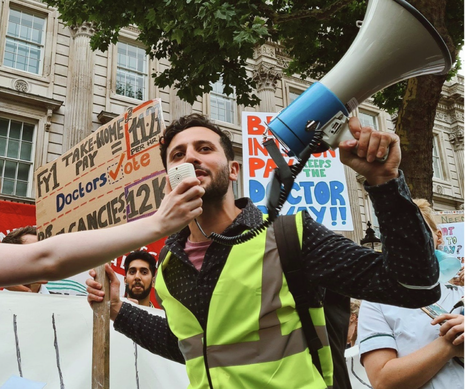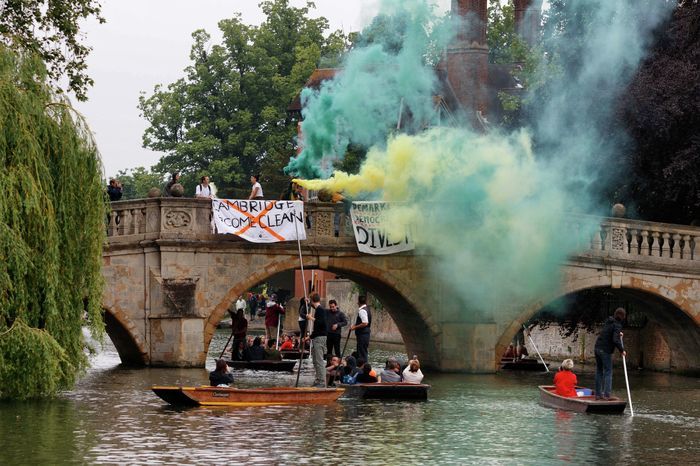How Cambridge medical students are rallying behind junior doctors
Joshua Newington speaks to the people behind the student movement to support the strikes

After 15 years of real term pay cuts, record levels of student debt and disappointing negotiations with the government, junior doctors began a 72 hour strike on March 13th. Outside Addenbrooke’s hospital in Cambridge, they won’t be alone. They’ll be joined by medical students, who see this as their fight too. I spoke to the people behind the student movement to support the strikes to understand why pay restoration matters to them.
Dan Zahedi, recent Cambridge graduate and co-chair of British Medical Association (BMA) East of England Junior Doctors committee sees this strike as having “more impact on medical students than anyone else,” highlighting that they will be in the profession longer than current doctors. After graduating, medical students can expect to earn £14 per hour, substantially less than they could earn working overseas or in other industries, something they are constantly reminded of by targeted ads.
“If you compare pay and hours to other countries, it’s difficult to find an objective reason to stay”
“Most major consultancy firms now have pathways set up to recruit medics,” says Kieran Cullen, president of Cambridge MedSoc. “If the NHS doesn’t provide workers the conditions they want then they will leave.” Every student I spoke to said the outcome of the strikes could directly impact their decision to stay in the NHS, and that many of their peers have considered working overseas. Even Dan felt that if the strikes didn’t result in a substantial pay offer, he would look elsewhere for work.
Mila, a fifth year student, registered for the BMA back in November to vote for a regional representative that supported the strikes and is planning on attending the protest outside Addenbrookes. Mila felt that staying in the NHS amounted to “enabling the powers that be to treat junior doctors inhumanely.” Under the current conditions, Mila said she would explore alternative careers despite knowing they could leave her unfulfilled: “staff are broken and unhappy, I’m not arrogant or naïve enough to think it won’t break me.” Limeng, the University’s deputy BMA representative, sees this as adding to the issue in the NHS about retaining doctors: “If you compare pay and hours to other countries, it’s difficult to find an objective reason to stay.”
Shortly after 98% of junior doctors voted in favour of the strikes, a WhatsApp group chat emerged, and a meeting was called at Thrive café where students discussed how to organise themselves into action, including collecting cardboard for sign making, booking rooms in the Clinical School and sourcing hot drinks for the picketers. Jean-Luc, a local BMA representative, recalled doing exactly that as a medical student during the 2016 junior doctor strikes. Now, he’ll be voluntarily running teaching sessions for medical students to make up for lost teaching during strikes.
Dan has organised volunteer-led teaching sessions for each of the strike days as well as rooms for doctors to take respite from the predicted rain. Ironically, the tea and coffee has been provided by the hospital trust itself. Dan sees medical students as a key part of making strikes a success. Even before ballots were announced he saw the potential value medical students have for the campaign “students have this unique ability to go to different regional hospitals.” Additionally, students receive teaching from consultants, giving them a precious face-to-face opportunity to get the senior colleagues on their side. Dan is hoping for around 40 medical students at Addenbrookes on strike days. While official picket lines are restricted to Trust members, medical students can be ‘picket visitors’ at least 2 metres from the picket line.
In contrast to many other universities, the dean of the Clinical School at Cambridge initially told students they were expected on placement as normal on strike days, because they could not risk students missing the education needed to be safe doctors. The Doctor’s Association UK claim the risk is high that students will be expected to cover junior doctor jobs. The power dynamic between students and clinicians could make it hard for students to decline taking on jobs they lack the professional indemnity to carry out. This would take the pressure off wards that the strikes aim to create, and was cautioned as a dangerous sign of desperation during the 2018 winter crisis. Perhaps from mounting pressure from students, the dean recently issued a welcome U-turn, stating students “won’t face any specific sanctions if they do not attend placement” but will need to ensure that they have adequate attendance over the whole placement.
A realistic understanding of the challenges of medicine is expected by medical school admissions tutors, but as Gabriel, another student, told me, there’s a difference between knowing it and having felt it. In the years since applying to university, students’ enthusiasm has been tested by an atmosphere of total burn-out. Gabriel described feeling disheartened by what he saw on placement. He witnessed “decisions about when to induce a pregnant person being about staffing availability rather than clinical need”. In real terms, medical school graduates will be paid 26% less than they were in 2008, but it is clear that they are no less valuable.
The dean initially called for uninterrupted placement for the sake of producing safe doctors, but perhaps nothing would produce safer doctors than an effective strike for a properly-funded NHS. These strikes are the last opportunity we have to retain many future doctors, and for this reason at least, the fight to reverse pay cuts shouldn’t be controversial.
 News / Cambridge students set up encampment calling for Israel divestment6 May 2024
News / Cambridge students set up encampment calling for Israel divestment6 May 2024 News / Cambridge postgrad re-elected as City councillor4 May 2024
News / Cambridge postgrad re-elected as City councillor4 May 2024 News / Proposed changes to Cambridge exam resits remain stricter than most7 May 2024
News / Proposed changes to Cambridge exam resits remain stricter than most7 May 2024 News / Some supervisors’ effective pay rate £3 below living wage, new report finds5 May 2024
News / Some supervisors’ effective pay rate £3 below living wage, new report finds5 May 2024 Fashion / Class and closeted identities: how do fits fit into our cultures?6 May 2024
Fashion / Class and closeted identities: how do fits fit into our cultures?6 May 2024





